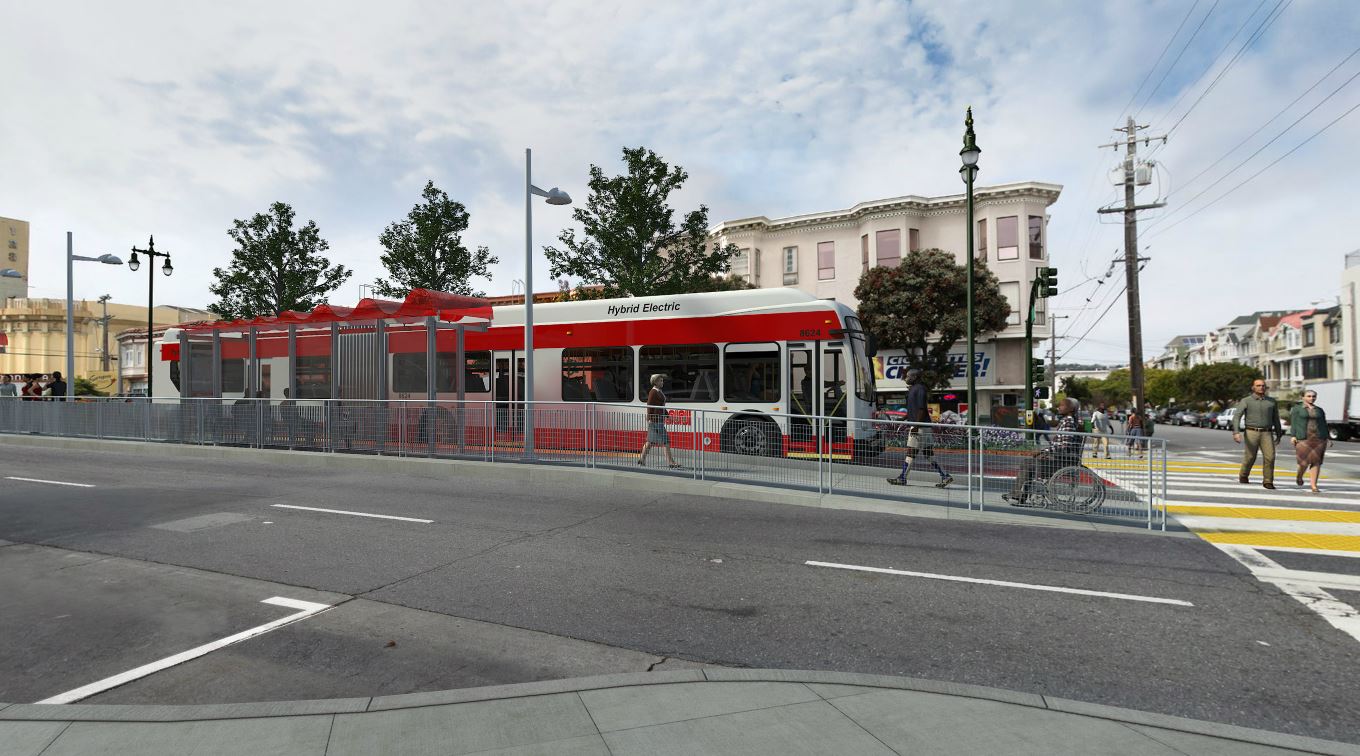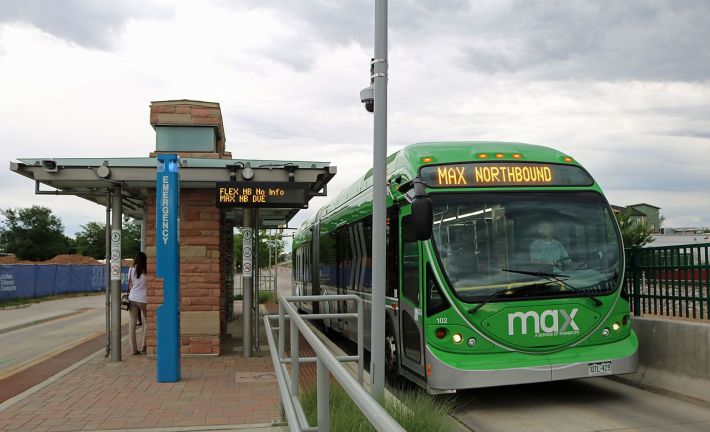Op-ed: Before Breed Axes Transit Chief, Crucial Changes Needed at City Hall
1:59 PM PDT on September 14, 2018

Geary rendering from SFMTA before it watered down the project and removed everything that actually made it BRT. Image: SFMTA
Last month, Mayor London Breed expressed frustration with Muni’s poor performance in a sternly-worded letter to Ed Reiskin, the city’s transportation director. The move signaled that Reiskin’s tenure might soon end. But if the mayor is going to throw him under the bus, she certainly knows not to count on it arriving on time. Only about half of the city’s buses show up according to schedule, a benchmark that no mayor in recent memory has been able to budge.
The time may have come for a new transit boss, but anyone who heads the San Francisco Municipal Transit Agency (SFMTA) will fail unless firm, decisive changes occur at City Hall.
The first priority: Create a bold vision for Muni. And it must come directly from our new mayor.
Mayor Breed should adopt the 30x30 plan, a promise to riders that the city’s buses and trains will get them anywhere within the city within 30 minutes by 2030. It may sound far-fetched, but it’s an idea the SF Transit Riders say is possible. An ambitious goal is essential because San Francisco officials have a habit of making decisions that sabotage the system’s speed and reliability. Examples are everywhere, including destroying a traffic circle and the city’s two Bus Rapid Transit (BRT) projects.
Elsewhere in the world, BRT operates as a surface subway. From Bogáta to Tehran, buses throttle past traffic on lanes unimpeded by private vehicles. Buses stop briefly at elevated platforms, each designed to be level with the floor of arriving buses. With no step up, people with strollers, groceries and wheelchairs board as quickly as they do from a subway platform.
These two features, dedicated lanes and level boarding, provide Bus Rapid Transit’s greatest speed and reliability improvements. But neither will be a part of San Francisco’s BRT projects, assuring that decades of dithering and $225 million will not amount to much.

The problems started in 2014, under Ed Reiskin’s leadership, when SFMTA argued that level boarding was impossible. The city’s buses have lug nuts that protrude too far from the wheels of buses, the agency said.
That’s a lousy excuse. The answer is simple: Get new buses.
But SFMTA does not want specialized buses for BRT, says Paul Rose, a spokesperson for the agency. “We need the ability to move buses around when needed,” he says.
But from Tanzania to China, cities with complex bus networks have acquired special buses to make level boarding work. Why can’t San Francisco?
Actually, we can. With years until either of San Francisco’s BRT projects will open (2020 for Van Ness and 2021 for Geary’s first phase) a strong-willed mayor could do what the last wouldn’t: push back.
The mayor could acquire new buses. And despite the current mess on Van Ness, construction on platforms hasn’t started on either project. The mayor could dust off earlier plans and have crews build proper platforms that allow level boarding.

But if level boarding happens, another blow to San Francisco’s BRT projects came last month when the SFMTA board voted to allow private shuttles in the lanes.
Tech shuttles, Chariot vehicles, double-decker tourist buses, Casino buses, and even airport shuttle vans can crowd into Geary's bus lanes. This breaks a promise to the public, wrote Susan Vaughan, a member of the SFMTA Citizens Advisory Council, who insists that exclusive lanes are what San Franciscans expect from BRT.
If the mayor can’t deliver true BRT, it’s time to ask a tough question: When the city finally completes these projects, will San Franciscans experience a notable upgrade?
The main thing people will see is a bunch of bus stops in the middle of the street. But with the most crucial “Rapid” features erased, center-lane bus stops will seem silly. In San Francisco, Bus Rapid Transit will amount to nothing more than Bus Transit, the same slow, lurching, stuck-in-traffic system that we already have.
Smaller transit improvements also get killed with swiftness and regularity. The traffic circle at Fulton and McAllister streets offers the latest example.
The circle was part of Muni’s 5-Fulton improvements to speed up travel times for the line’s 20,000 daily riders. The city approved the project after a community outreach process that engaged more than 2,000 people. But soon after crews installed it, the Alamo Square Neighborhood Association complained to their supervisor behind closed doors. And that’s all it took. Without talking to transit riders, this “transit first” city promptly bulldozed the circle.
Privately, SFMTA planners tell Streetsblog that city supervisors routinely interfere to stop improvements when neighbors express resistance to change. Although the traffic circle may seem insignificant on its own, small speed enhancements are more important than they may seem.

SFMTA’s Muni Forward program intends to speed up 76 bus and rail lines. Imagine that the agency could cut two minutes from the travel time of each line. When each route completed its first run of the day, Muni would gain 2.5 hours of service.
With several vehicles assigned to every route, each completing many runs per day, that two-minute benefit would accumulate across the entire system, adding up to hundreds of service hours every day. The impact for San Francisco would be like getting dozens of new buses and drivers for free, a service upgrade that would cascade throughout the system, creating faster and more reliable service across the city.
But when a supervisor fields complaints from neighbors, they might ask: What is Muni Forward anyway? What is its goal? When will it be achieved? Are San Franciscans behind it?
The program’s results tell you everything you need to know. Since Muni Forward launched in 2015, our transit system’s on-time performance rate remains at 53 percent, the system continues to be one of the slowest in the developed world, and ridership has not grown.
The failure of Muni Forward is precisely why Mayor Breed needs an ambitious plan of her own.
It must have a simple, clearly-expressed goal. Similar to a city preparing to host the Olympics, a hard, non-negotiable deadline must be backed up with the full force of the mayor’s office. And, unlike Muni Forward, a majority of San Franciscans need to understand and support the plan.
As the mayor’s new blueprint comes into focus, it will guide other critical reforms.
- The agency should drastically change its public engagement process. The current approach, with its flyers, surveys, hearings, and neighborhood meetings, achieves little more than angry, unproductive fights that go on for far too long. The agency should work with outside experts to define its engagement goals and professionalize its process.
- After a successful engagement process, new city policy should be enacted to prevent supervisors and the SFMTA board from interfering with the resulting projects.
- The unelected SFMTA board, formed in 1999 and accountable only to the mayor, has not worked. Although it gives the mayor power that she may be reluctant to give up, the good of the city should come first. She should briefly look at transit governance models around the world and offer voters an alternative in time for the 2020 election.
- The mayor should restructure SFMTA so that a single person is accountable for Muni and nothing else.
- Elected officials should ride transit, and not just in San Francisco. Since the United States offers few examples of fast, reliable public transportation, taxpayers should fund overseas trips specifically to give officials first-hand experience with world-class transit.
Could Muni become as fast and reliable as transit in Tokyo, Istanbul, or even Fort Collins? I think it can — and London Breed just might be the mayor to pull it off.
To express your support for the 30x30 plan, send an e-mail to Mayor Breed’s office at MayorLondonBreed@sfgov.org.
Read More:
Stay in touch
Sign up for our free newsletter
More from Streetsblog San Francisco
Commentary: There is Zero Ambiguity to the West Portal Tragedy
What happened in West Portal was entirely predictable and preventable. The city must now close Ulloa to through traffic and make sure it can never happen again
Independent Safety Advocates Beef up the Wiggle
Signs and soft-hit posts installed by advocates make the Wiggle bike route calmer and safer for cyclists and pedestrians




